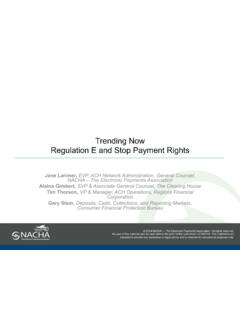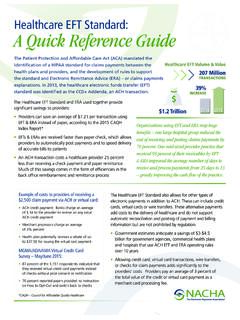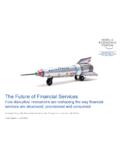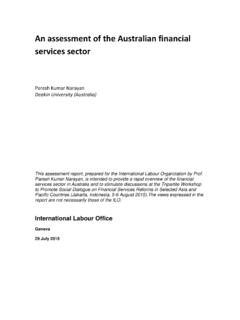Transcription of API Standardization - Shaping the Financial Services Industry
1 1 API Standardization Shaping THE Financial Services Industry API Standardization - Shaping the Financial Services Industry 2018 NACHA THE ELECTRONIC PAYMENTS ASSOCIATION . ALL RIGHTS 2 API Standardization Shaping THE Financial Services Industry The purpose of this document is to provide insight into the approach of the API Standardization Industry Group (ASIG)* towards defining API standards in Financial Services , the development activities and future work efforts of the Group and the Industry efforts underway to promote interoperability with other global initiatives. The document also details resources available to the Financial Services ecosystem including the new developer document is divided into the following sections:Document Introduction APIs in Financial ServicesBenefits of StandardizationMomentum Behind API Standardization in the US - Key MilestonesDefining the Standardized APIsAdvancing the InitiativeIntroductionAPI Initiatives Around the GlobeClosing - Get Involved* The API Standardization Industry Group is sponsored by the Payments InnovationAlliance, a membership group of NACHA - The Electronic Payments Standardization Shaping THE Financial Services Industry 3 API Standardization Shaping THE Financial Services Industry Many payments providers, Financial institutions and leading Financial Services firms have been using APIs to broaden and enhance Services , increase automation and strengthen security.
2 But without Standardization , businesses and their consumers cannot reap thefull potential of APIs. Currently, banks use disparate and customized formats to share information, employing different nomenclatures for common terms and processes. Without Standardization , every time a developer tries to create or update an app, changes to that app will be required to interact with each bank. With Standardization , a developer could design and implement one app that would interact with countless banks without needing modifications. The role of Standardization is to help streamline and simplify implementation across organizations and technologies to lower the total cost of ownership (TCO) and create efficiencies across the ecosystem. This results in easier development, deployment and integration into existing and new solutions. Having 1,000+ banks enable a common service using 1,000+ different versions of an API is not efficient.
3 Standardization is a critical component to ensure consistency, compatibility, effectiveness, sustainability and is a foundational component of Standardization . Governance helps to ensure an effective framework and process is in place to safeguard and support initiation, development, testing and implementation from the outset, inclusive of definition, maintenance and certification of the standard. The payments landscape continues to undergo significant changes domestically and globally. For stakeholders across the Industry , managing the impact of emerging technologies, faster payments initiatives and increased global regulation while trying to remain customer centric have become a balancing act of shifting parts. Organizations across the Industry are trying to figure out how to prioritize their payments strategies, maintain compliance and keep up with the pace of change.
4 Implementing standardized Application Programming Interfaces (APIs) is increasingly important for Financial Services firms as they strive to provide differentiated digital experiences and tailored customer offerings faster and more efficiently. These digital experiences extend beyond the traditional boundaries of the bank franchise and it is through APIs that leading institutions are reaching new customers, delivering new Services and doing so with lower incremental capabilities are opening pathways to new ways of working internally and externally with customers on their terms, coupled with the increasing expectation to connect seamlessly for faster decision making. Standardized APIs enable this to happen more easily, while supporting scale to allow for the exchange of information more efficiently and effectively than traditional mechanisms. While APIs are not a new idea, their familiarity, ease of use and the ecosystem of tools that support them have enabled APIs to be available to the masses.
5 The transcendence of APIs, beyond traditional IT departments into the business areas of organizations is driving market relevance. From a business perspective, APIs are products that offer new ways to connect with customers. APIs can provide access to Financial Services where and when customers need them in an interactive manner outside of the traditional bank product environment such as portals and other bank user interfaces. Enabling standardized APIs provides consistency that will unlock value across the Financial Services ecosystem by improving time to market, shortening development lifecycles and reducing implementation costs. The API Standardization Industry Group (ASIG) was founded by NACHA in response to calls from the Financial Services Industry for improved Standardization and governance for API usage in the and globally. The membership includes more than 1 0 organizations representing diversified stakeholders.
6 The mission of the Group is to create a standardized API ecosystem that can enhance support of the payments and other business needs of Industry participants. The Group s focus is the development of standardized APIs addressing key requirements such as risk reduction, interoperability, efficiency, and improved access. Through its Standardization efforts, the Group seeks to meet the evolving needs of the Financial Services Industry by improving the safety and transparency of transactions, increasing efficiencies and speed of communications, and enhancing support of payments innovations. Application Programming Interfaces (APIs) are not new, but the way they are now being deployed, transcending traditional back-office uses, is reinventing the way companies interact and IntroductionAPIs in Financial ServicesAPI Standardization and operational domains into a core component in enhancing existing solutions and enabling new, value-creating product innovation.
7 Within this new paradigm, APIs are becoming simpler and more user friendly, expanding the user community and solution tangibility by bridging legacy enterprise silos as well as business stakeholders. In a changing Financial Services market, APIs are playing a primary role as connectors within banking and payments systems. While the role of APIs in the context of European Union regulatory reforms such as the Payment Service Directive 2 (PSD2) / Open Banking initiative is well publicized; it is an accelerating trend around the world that allows bank customers to interact with their bank outside of the traditional banking product and service environment through initiatives such as bank-branded portals and online tools. It requires Financial institutions to grant third-party providers access to customer data via APIs providing greater access to customer data and payment infrastructures. The domestic landscape is no exception and through the combined efforts of stakeholders corporations, Financial institutions, fintechs, service providers, standards bodies and advisory firms the Industry value of standardized APIs is becoming increasingly clear.
8 Standardized APIs offer new ways for banks to extend their digital capabilities to enable innovation and meet varied client needs across market segments without breaking the budget. Opportunities to enhance the customer experience and create new revenue streams will emerge through the work efforts of the API Standardization Industry Group (ASIG).0how information is shared. APIs have evolved from infrastructure 4 API Standardization Shaping THE Financial Services Industry API Initiatives Around the Globe As previously mentioned, APIs in the Financial Services Industry have not only been in the forefront in Europe with the Payment Services Directive 2 (PSD2), but are also prevalent around the globe with the goal of driving increased transparency, competition and innovation. Here is a snapshot of API initiatives across Financial Services taking shape in the UK, Singapore, Australia, Hong Kong, Japan and Mexico.
9 UK In the UK, the Competition and Markets Authority (CMA) mandated nine banks in the region to enable their consumer and small businesses customers to share their data securely with other banks and with third parties. The initiative, led by CMA, is labelled Open Banking. In 2017, the scope was expanded to include credit cards, e-wallets and prepaid cards. With registration through the open banking directory, third parties, such as fintechs and digital service providers, can work with leading Financial institutions on new solutions that improve and redefine client November 2016, the Monetary Authority of Singapore (MAS) and the Association of Banks published the Finance-as-a-Service: API Playbook. It identified 411 APIs covering banks, insurers, asset management companies and government agencies. These APIs were categorized into functions including marketing, product, payments, regulatory, sales, and servicing.
10 While the adoption is voluntary, the market interest is strong. Today, over 250 APIs have been made The first phase of the Open Banking reform will be introduced by July 2019. Customers of the big four banks will be able to use this mandate to share transaction, deposit, and debit and credit card data to other accredited Financial Services providers. The Australian Data Standard Setting Body will design the standards. The UK technical specification will be utilized as a starting point for the standards KongIn January 2018, the Hong Kong Monetary Authority (HKMA) issued a consultation on Open API framework, which sets out the HKMA s intended approach to for the banking Industry in Hong of March 2018, the Japanese Banking Act requires banks to announce support on Open API banking. The implementation timeline is middle of 2020. A comprehensive framework will be published covering security, user protection and specifications about the delivery of the Open API initiative.

















